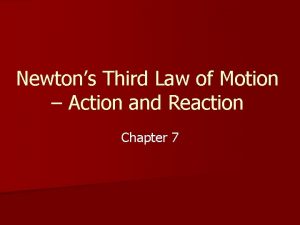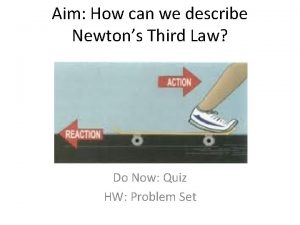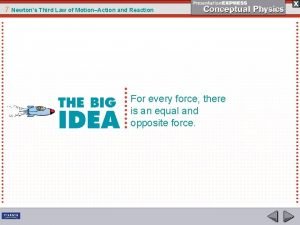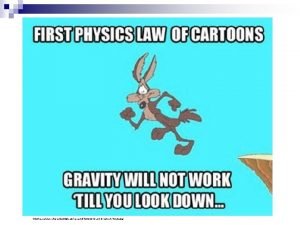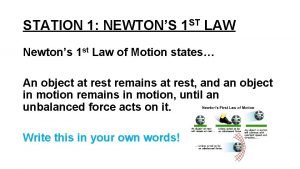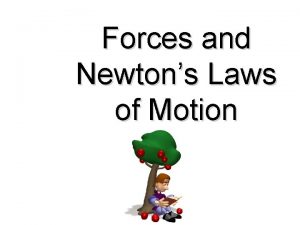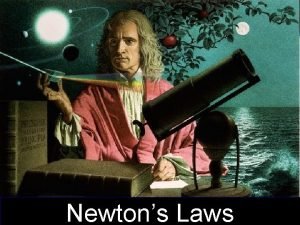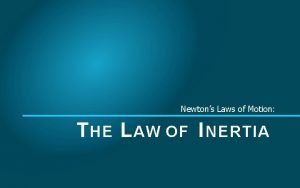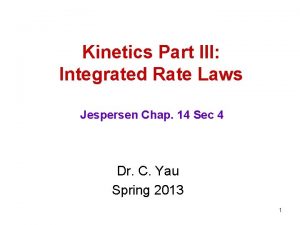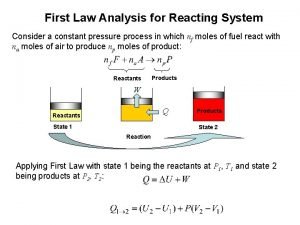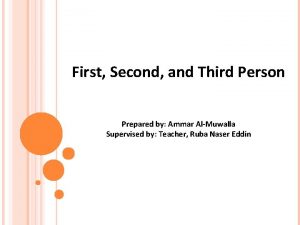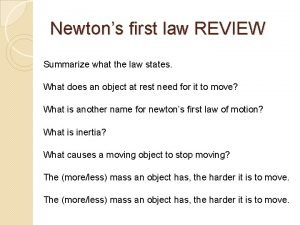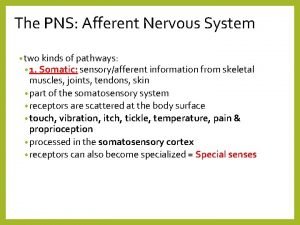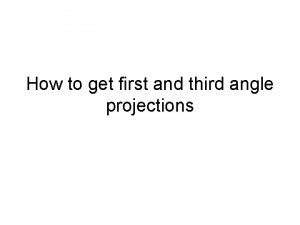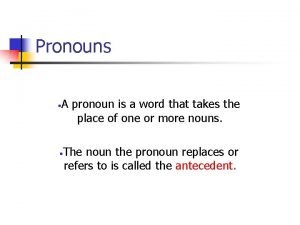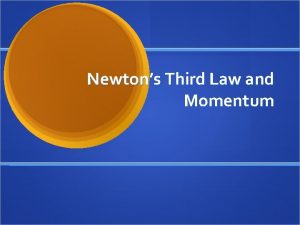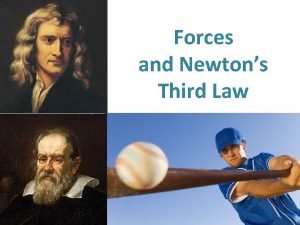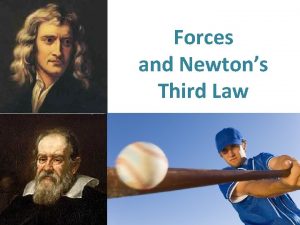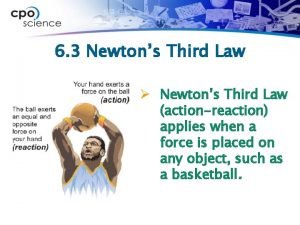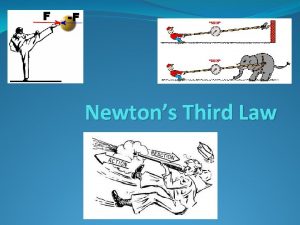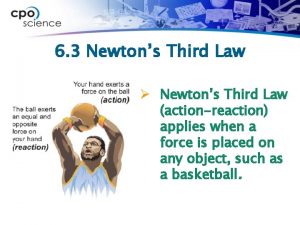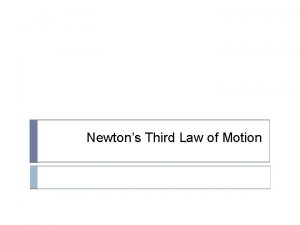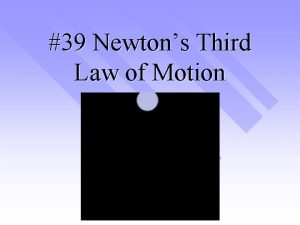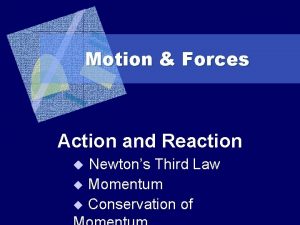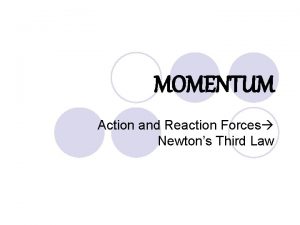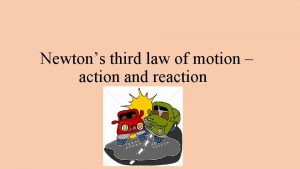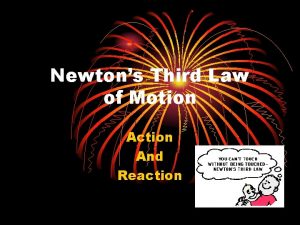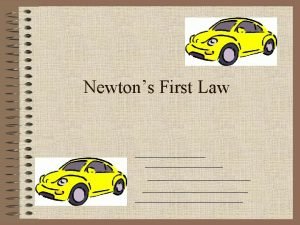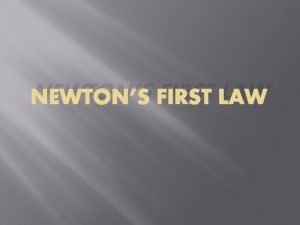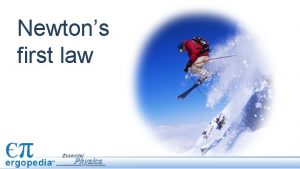Newtons Third Law Action and Reaction Newtons First


































- Slides: 34

Newtons Third Law – Action and Reaction

Newton’s First and Second Laws – a review • First – Law of Inertia: an object at rest or in motion will remain that way until acted upon by an unbalanced force. • Second – Law of Mass & Acceleration: F = ma


Newtons Third Law – Action and Reaction

Objetives: (please write into the cue column) • • I can list Newton’s third law of motion. I can define force. I can identify action-reaction on different masses. • I can use Newton’s third law to explain how rockets and helicopters work. • I can explain why action-reaction forces do not cancel.

For every force, there is an equal and opposite force.


Interactions Produce Forces • A force is a push or pull. • On closer inspection, it is an interaction between one thing and another.

Interactions Produce Forces • When hitting a nail with a hammer, the nail is driven into the wood. • The nail must also exert a force on the hammer to stop it from moving.

Interactions Produce Forces • This leads us to Newton’s third law, the law of ACTION and REACTION

Newton’s rd 3 Law • Whenever one object exerts a force on a second object, the second object exerts an equal but opposite force on the first object. • For every ACTION force, there is an equal opposite REACTION force.

Newton’s rd 3 Law • One force is called the action force and the other force is called the reaction force. • Neither force can exist with out the other.

Identifying Action & Reaction • Sometimes not easy to identify the Action Reaction pair. • Use this rule Object A exerts a force on Object B then in reverse Object B exerts a force on object A

Identifying Action & Reaction

Identifying Action & Reaction

Identifying Action & Reaction

Identifying Action & Reaction • Action: Tire pushes road • Reaction: Road pushes tire

Identifying Action & Reaction

Identifying Action & Reaction • Action: Rocket pushes gas • Reaction: Gas pushes rocket

Identifying Action & Reaction

Identifying Action & Reaction • Action: Earth pulls ball • Reaction: Ball pulls Earth

Identifying Action & Reaction

Identifying Action & Reaction The dog wags the tail and the tail wags the dog.

Action and Reaction on Different Masses • In the example of the ball falling to the Earth, can we say the Earth falls towards the ball?

Action and Reaction on Different Masses • YES!!! But not as much. • Why? • Although the size of the force is the same, the masses are different.

Action and Reaction on Different Masses • Small mass on bullet, LARGE acceleration.

Action and Reaction on Different Masses • By considering the recoil of a gun we can understand rocket propulsion. • Instead of bullets coming out of the rocket, it’s a gas!!

Action and Reaction on Different Masses The rocket recoils from the “molecular cannonballs” it fires and climbs upward.

Action and Reaction on Different Masses Using Newton’s third law, we can understand how a helicopter gets its lifting force. • The whirling blades force air particles downward (action). • The air forces the blades upward (reaction). • This upward reaction force is called lift. • When lift equals the weight of the craft, the helicopter hovers in midair. When lift is greater, the helicopter climbs upward.

Why Action and Reaction Forces Don’t Cancel • In every interaction, one thing interacts with the other and vice versa. A on B & B on A. • Why don’t they cancel out?

Why Action and Reaction Forces Don’t Cancel • The answer is that the pair of forces act on different objects. Although A acts on B and B acts on A, the individual forces themselves act on different objects. The ball accelerates away and your foot slows down when it hits the ball.


Action Equals Reaction

 Newton's first law and second law and third law
Newton's first law and second law and third law Newton's first law and second law and third law
Newton's first law and second law and third law According to the third law of motion action and reaction
According to the third law of motion action and reaction Law of motion 3rd
Law of motion 3rd Describe newtons third law
Describe newtons third law Third law of thermodynamics derivation
Third law of thermodynamics derivation Newton’s 3rd law
Newton’s 3rd law Newtons third law of motion
Newtons third law of motion Newton's third law
Newton's third law What are newton's laws
What are newton's laws More inertia
More inertia Newton's first law meme
Newton's first law meme What is one newton
What is one newton Newton's laws
Newton's laws What is motion
What is motion A girl is suspended motionless from the ceiling by a rope
A girl is suspended motionless from the ceiling by a rope Reaction rate equation
Reaction rate equation Cosa afferma la legge di gravitazione universale
Cosa afferma la legge di gravitazione universale Newtons second lw
Newtons second lw Newtons first ;aw
Newtons first ;aw Rate law for first order reaction
Rate law for first order reaction First law analysis of combustion process
First law analysis of combustion process Odontoclasia meaning
Odontoclasia meaning G j mount classification of caries
G j mount classification of caries Talking about yourself in third person example
Talking about yourself in third person example Mustafa sheikh
Mustafa sheikh E1cb elimination reaction
E1cb elimination reaction Half life formula
Half life formula Boyle's law charles law avogadro's law
Boyle's law charles law avogadro's law Avogadro's law constants
Avogadro's law constants Neuron order
Neuron order Difference between 1st and 3rd angle projection
Difference between 1st and 3rd angle projection Rubrospinal tract
Rubrospinal tract First second and third normal form
First second and third normal form Reflexive pronouns
Reflexive pronouns


